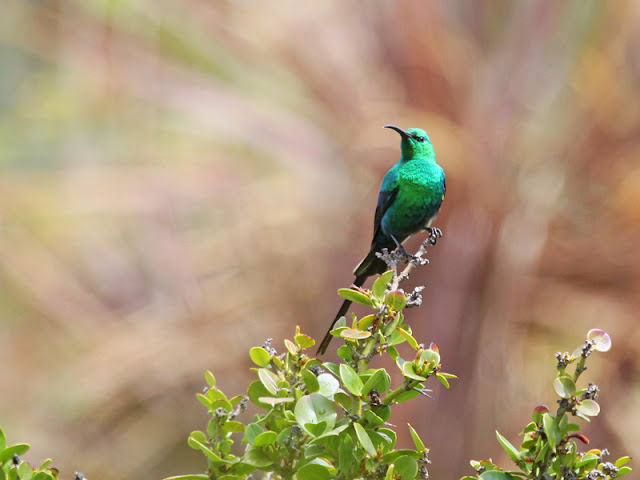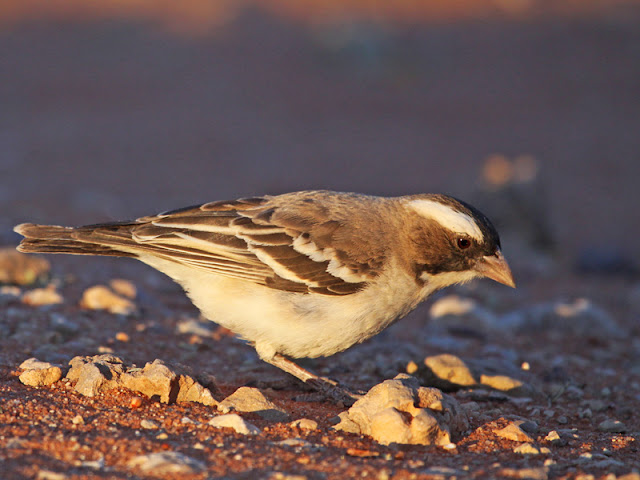 |
| Interesting place names in Kgalagadi |
26 Sept 2009 - After signing out at the reception building we set off on the road to Nossob. Immediately things started to happen with a Verreauxs (Giant) Eagle-Owl sitting in a tree next to the road not 100m from the gate.
 |
| Verreauxs Eagle-Owl |
Then our first close ups of Sociable Weavers which build huge grass nests housing several birds including Pygmy Falcons, Barn Owls and even the odd Cape Cobra. The Verreauxs Eagle-Owls often nest on top of them..
 |
| Sociable Weaver |
 |
| Sociable Weaver Nest (note weaver flying past to guage size) |
The sand here is very red and we noticed lots of little holes in the ground which housed some interesting mammal species that neither I nor my family had never seen before.
 |
| Brants Whistling Rat |
 |
| Four-striped Mouse |
We started seeing larger mammals like Blue Wildebeest which were common in the park, the iconic Springbok and the smaller Steenbok. The road to Nossob from Twee Rivieren normally follows the Nossob river but due to extensive road works we were re-routed along the Auob River to Kamqua where we were to take the upper dune road to Dikbaardskolk and then continue along the Nossob river to Nossob camp. The habitat was very dry and we picked up a few of the dryland bird species like Black-chested Prinia, Chat Flycatcher, Namaqua Sandgrouse and the colourful Swallow-tailed Bee-eaters which proved to be very common in the park.
 |
| Black-chested Prinia |
 |
| Chat Flycatcher |
 |
| Namaqua Sandgrouse |
 |
| Swallow-tailed Bee-eater |
We encountered Red Hartebeest and our first Oryx (Gemsbok), the parks emblem along the dry Aoub river.
 |
| Red Hartebeest |
 |
| Oryx (Gemsbok) |
Ostrich were seen in the riverbed and a lone Cape Crow.
 |
| Female Ostrich |
 |
| Cape Crow |
As the day started warming up we picked up raptors catching the thermals overhead, among others Tawny Eagles and Black-breasted Snake-Eagle.
 |
| Tawny Eagle |
 |
| Immature Black-breasted Snake-Eagle |
The day was really heating up and birds were looking for whatever cover they could find to escape the relentless sun. Luckily the trucks air-conditioning helped us to stay cool although the opening of windows to take photos didn't go down well with the rest of the family as it let all the warm air in and the cooling had to start all over again. Along the dune road we saw a few larks including a form of Spike-heeled Lark with a much longer bill than "ours" back in Gauteng. Fawn-coloured Larks were the most ubiquitous of the lark family.
 |
| Spike-heeled Lark |
 |
| Fawn-coloured Lark |
Other birds seen along the dune road were a Lanner Falcon, too far for a good photo, a couple of Secretarybirds and a Kori Bustard resting in the shade under a Shepherds tree.
 |
| Secretarybird |
 |
| Kori Bustard |
Eventually after a long hot drive we reached the picnic site at Dikbaardskolk where we could get out and stretch our legs. Birds in the picnic areas are very tame and boldly approach you for a handout or two. At this picnic site it was a Kalahari Scrub-robin. Other birds in the picnic area were Sociable Weavers and Violet-eared Waxbill.
 |
| Kalahari Scrub-robin |
All along the road we encountered lizard like reptiles I immediately named them Commando Lizards because they appeared to be wearing camouflage outfits. I later found out that they were actually Ground Agamas..
 |
| Commando Lizard (Ground Agama) |
Getting nearer to Nossob, we decided to take a detour to visit Marie se Gat (Maries hole) which is so named because the man contracted to dig the well used to get so drunk he couldn't work, so his wife got in and completed the well alone!! The trees in the riverbed held some birds, one of which was occupied by a White-backed Vulture pair and further down a lone Tawny Eagle.
 |
| White-backed Vultures |
 |
| Tawny Eagle |
Here we also found our first predatory mammals. A Black-backed Jackal and in the distance, two pairs of ears sticking above the river bank gave away a pair of Cheetah lying in the shade. After a long wait they hadn't moved so we continued on our journey.
 |
| Black-backed Jackal |
 |
| Cheetah |
Flocks of Scaly-feathered finch were very busy around the waterhole and I thought I saw my first Red-necked Falcon but could not be sure..
 |
| Scaly-feathered Finch |
Finally we arrived at Nossob after about 5 hrs on the road in the hot sun, luckily it was only autumn... At the gate to the camp I had the pleasure of spending time with another very confiding bird, a Crimson-breasted Shrike! I sat on the ground quietly and he/she carried on foraging around me as if I wasn't there, it was quite frustrating as the bird came soo close I couldn't focus sometimes.
 |
| Crimson-breasted Shrike |
After a nice cooling swim in the camp pool and an ice cold beer from the freezer I spent the last minutes of the day on the patio of our chalet enjoying the sunset. After the sun had set the camp was filled with the beautiful clicking sounds of the Barking Geckos, a sound I will always associate with Kgalagadi, and the churring sound of Rufous-cheeked Nightjar calling from inside the camp. My son and I set off immediately to locate these potential photo lifers and without too much effort found one calling not from our chalet.
 |
| Rufous-cheeked Nightjar |
What a day, filled with wildlife and beautiful panoramas! I could see why people say that once you have been to Kgalagadi you will always want to come back. I couldn't wait to hit the road again in the morning to see what other treasures awaited us in this wonderland!
























































